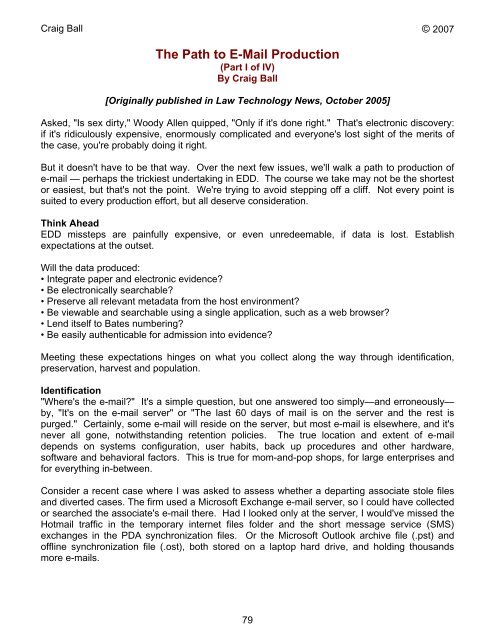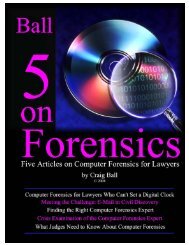Six Articles on Electronic - Craig Ball
Six Articles on Electronic - Craig Ball
Six Articles on Electronic - Craig Ball
You also want an ePaper? Increase the reach of your titles
YUMPU automatically turns print PDFs into web optimized ePapers that Google loves.
<strong>Craig</strong> <strong>Ball</strong> © 2007<br />
The Path to E-Mail Producti<strong>on</strong><br />
(Part I of IV)<br />
By <strong>Craig</strong> <strong>Ball</strong><br />
[Originally published in Law Technology News, October 2005]<br />
Asked, "Is sex dirty," Woody Allen quipped, "Only if it's d<strong>on</strong>e right." That's electr<strong>on</strong>ic discovery:<br />
if it's ridiculously expensive, enormously complicated and every<strong>on</strong>e's lost sight of the merits of<br />
the case, you're probably doing it right.<br />
But it doesn't have to be that way. Over the next few issues, we'll walk a path to producti<strong>on</strong> of<br />
e-mail — perhaps the trickiest undertaking in EDD. The course we take may not be the shortest<br />
or easiest, but that's not the point. We're trying to avoid stepping off a cliff. Not every point is<br />
suited to every producti<strong>on</strong> effort, but all deserve c<strong>on</strong>siderati<strong>on</strong>.<br />
Think Ahead<br />
EDD missteps are painfully expensive, or even unredeemable, if data is lost. Establish<br />
expectati<strong>on</strong>s at the outset.<br />
Will the data produced:<br />
• Integrate paper and electr<strong>on</strong>ic evidence?<br />
• Be electr<strong>on</strong>ically searchable?<br />
• Preserve all relevant metadata from the host envir<strong>on</strong>ment?<br />
• Be viewable and searchable using a single applicati<strong>on</strong>, such as a web browser?<br />
• Lend itself to Bates numbering?<br />
• Be easily authenticable for admissi<strong>on</strong> into evidence?<br />
Meeting these expectati<strong>on</strong>s hinges <strong>on</strong> what you collect al<strong>on</strong>g the way through identificati<strong>on</strong>,<br />
preservati<strong>on</strong>, harvest and populati<strong>on</strong>.<br />
Identificati<strong>on</strong><br />
"Where's the e-mail?" It's a simple questi<strong>on</strong>, but <strong>on</strong>e answered too simply—and err<strong>on</strong>eously—<br />
by, "It's <strong>on</strong> the e-mail server" or "The last 60 days of mail is <strong>on</strong> the server and the rest is<br />
purged." Certainly, some e-mail will reside <strong>on</strong> the server, but most e-mail is elsewhere, and it's<br />
never all g<strong>on</strong>e, notwithstanding retenti<strong>on</strong> policies. The true locati<strong>on</strong> and extent of e-mail<br />
depends <strong>on</strong> systems c<strong>on</strong>figurati<strong>on</strong>, user habits, back up procedures and other hardware,<br />
software and behavioral factors. This is true for mom-and-pop shops, for large enterprises and<br />
for everything in-between.<br />
C<strong>on</strong>sider a recent case where I was asked to assess whether a departing associate stole files<br />
and diverted cases. The firm used a Microsoft Exchange e-mail server, so I could have collected<br />
or searched the associate's e-mail there. Had I looked <strong>on</strong>ly at the server, I would've missed the<br />
Hotmail traffic in the temporary internet files folder and the short message service (SMS)<br />
exchanges in the PDA synchr<strong>on</strong>izati<strong>on</strong> files. Or the Microsoft Outlook archive file (.pst) and<br />
offline synchr<strong>on</strong>izati<strong>on</strong> file (.ost), both stored <strong>on</strong> a laptop hard drive, and holding thousands<br />
more e-mails.<br />
79













